Melianthus major
Melianthus major L.
Family: Melianthaceae
Common names: honey flower, melianthus, giant honey flower, touch-me-not (Eng.); kruidjie-roer-my-nie, heuningblom, klappers, krikkiebos (Afr.); ubuhlungubemamba, ubutyayi (Xhosa), ibonya (Zulu)
Introduction
With its decorative blue-green leaves and tall, dark rusty-red flower heads, this is a striking plant. On a sunny day the birds feast on the nectar dripping from the flowers, but any one touching those attractive leaves is in for a surprise; their strong unpleasant smell warns that it is highly toxic.
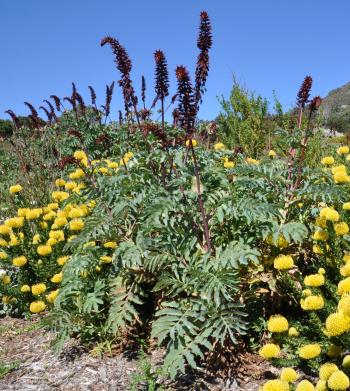
Description
Description
A fast-growing, vigorous perennial, Melianthus major grows about 2.5 m tall, suckering and spreading to about 3.5 m as it goes. The distinctive large, smooth leaves are a light bluish-green, deeply divided, with a winged rachis, toothed leaflets, a ruffled surface and a strong, unpleasant, nutty odour when touched.

The leaves are placed at intervals up the thick stems. The flower spikes grow out from the tip of the stems in spring (August to September), rising up above the leaves, drawing attention with their unusual dark maroon to rusty reddish colouring. These flower spikes are racemes made up of many dark maroon flowers.
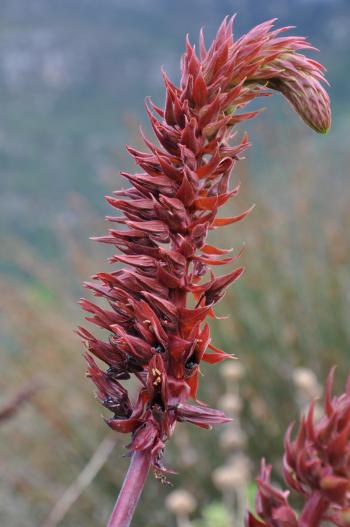
On closer inspection, one can see a dark black structure in the lower part and 4 anthers and the stigma in the upper part of the flower. The showy, dark maroon flower is made up of 5 sepals, the outer envelope of the flower. The petals are very much smaller and are hidden inside the sepals. The black structure is a cup-shaped nectary, which is large and well developed and situated on the receptacle (base of the flower), which has been extended to form a mentum (like a chin), both of which are enclosed by one of the maroon sepals. The nectary produces copious quantities of black nectar.
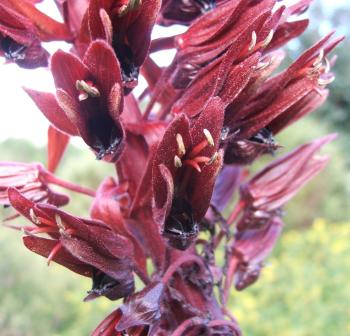
The flowers resupinate when mature, which means that they turn upside down, due to the petiole twisting through 180°. When in bud and freshly open, they have the nectary at the base of the flower and when pollinated they close again and twist around and hang upside down, with the sepal that encloses the nectary on top.

The flowers are followed by pale green, 4-chambered, bladder-like pods, drying to pale brown, and containing the shiny black seeds.
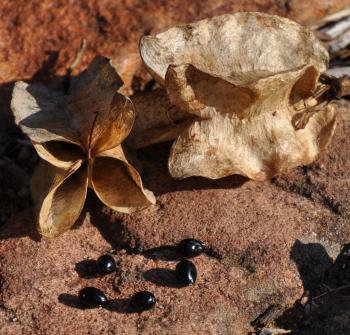
Conservation Status
Status
According to the Red List of South African plants, Melianthus major is not threatened and its wild population is stable; it is thus assessed as Least Concern (LC).
Distribution and habitat
Distribution description
Melianthus major occurs in the Western, Eastern and Northern Cape Provinces of South Africa, growing on sandstone slopes, often along streams, from the Bokkeveld Plateau in the Northern Cape, through the Western Cape and into the Eastern Cape.
Derivation of name and historical aspects
History
The genus Melianthus means ‘honey flower’, from the Greek meli, meaning ‘honey’ and anthos, ‘flower’, referring to the nectar-rich flowers. The name ‘honey flower’ was in use long before its scientific name Melianthus was published, the species was introduced to horticulture in Holland in 1673, and only named by Linnaeus in 1753. The species name major, is Latin and means ‘larger’ or ‘greater’, because this is the largest of the species. The Afrikaans common name kruidjie-roer-my-nie, which means ‘touch-me-not-herb’, refers to the unpleasant smell of the leaves when they are touched.
There are 6 species of Melianthus, all of which are found in southern Africa, in a wide range of habitats. A species sometimes seen in cultivation is Melianthus comosus, which occurs in Namibia and the western Karoo, through the Little Karoo into the Eastern Cape, and is also known as honey flower or kruidjie-roer-my-nie. The other species are: M. dregeanus (red honey flower), M. elongatus, M. pectinatus and M. villosus (maroon honey flower).
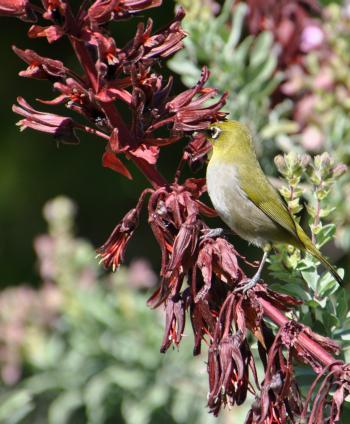
Ecology
Ecology
Melianthus major comes from the winter-rainfall region of South Africa and grows actively in the rainy winter season. During the summer dry season, the plants that receive no water may die back, but the rootstock survives and sends up new stems when the rain returns in autumn. Plants that receive water all year remain evergreen, with new growth initiated with the beginning of the rainy season, in autumn.
The flowers produce an abundance of nectar and are pollinated by birds. They are visited by nectar-feeding birds, such as sunbirds, and occasional nectar-feeders such as white-eyes and red-winged starlings. They are also visited by bees and Melianthus is said to produce good honey, despite the toxicity of the rest of the plant.
The inflated, papery seed capsules are light in weight and are dispersed by wind and water.
Leaves are toxic to grazing animals, causing death in a few hours. The toxic principle remains active even in dried leaves. The roots are also poisonous.
Uses
Use
Please note that this plant is toxic when taken internally, treat it with caution. It is used in traditional medicine. The leaves are used to make poultices and decoctions to treat septic wounds, sores, ulcers, boils, abscesses, bruises, backache, painful feet and rheumatic joints. The roots and leaves are used to treat snakebite, or taken in very small doses as a tonic. It is also used to make a gargle for sore throats and mouth infections. Dried flowers and leaves can be used to keep insects out of cupboards.
Growing Melianthus major
Grow
Melianthus major is an easy garden plant, grown worldwide for its lush, attractive foliage. It prefers a warm, well-watered, sunny position, with good drainage. Although quite tough and adaptable, it will flourish in deep, rich soil, especially if given plenty of water. Melianthus grows fast and will make a show within a few months. It is particularly attractive in spring, when in flower and sporting its new lush leaf growth, after the wet Cape winter. Make sure to give it enough room to spread. It is well suited to a position beside a water feature or pond. It looks good in a mixed border, it makes a striking accent plant and is suitable for large containers.
During the dry summers or whenever the plants are untidy, they should be cut back hard, to encourage new growth. The plants can survive in cold areas with frost, sending new shoots from the base in spring.
Melianthus major grows very easily from seed or cuttings. The seed is sown in autumn in seed trays filled with a well-drained medium and covered lightly with sand or finely milled bark. Germination is usually within a month. The young seedlings are potted up into bags or small pots and grown on until strong enough to be planted out into the garden. The cuttings can be made any time of the year depending on material available. Cuttings are made from the new shoots sprouting from the base.
References
- Foden, W. & Potter, L. 2005. Melianthus major L. National Assessment: Red List of South African plants version 2017.1. Accessed on 2017/05/30.
- Goldblatt, P. & Manning, J. 2000. Cape Plants. A conspectus of the Cape flora of South Africa. Strelitzia 9. National Botanical Institute, Pretoria & Missouri Botanical Garden, Missouri.
- Hutchings, A., Scott, A.H., Lewis, G. & Cunningham, A.B. 1996. Zulu medicinal plants: an inventory. University of Natal Press, Pietermaritzburg.
- Jackson, W.P.U. 1990. Origins and meanings of names of South African plant genera. University of Cape Town.
- Joffe, P. 2001. Creative gardening with indigenous plants. Briza Publications, Pretoria.
- Kubitzki, K. (ed.). 2007. The families and genera of vascular plants. Vol 9. Flowering Plants. Eudicots. Berberidopsidales to Sabiaceae. Springer, Berlin.
- Loudon, Mrs (J.). 1843. The ladies’ flower-garden of ornamental perennials, Volume 1. William Smith. London.
- Roberts, M. 1990. Indigenous healing plants. Southern Book Publishers, Halfway House, Johannesburg.
- Ronse De Craene, L.P. 2010. Floral diagrams. An aid to understanding flower morphology and evolution. Cambridge University Press, Cambridge.
- Smith, C.A. 1966. Common names of South African plants. Memoirs of the Botanical Survey of South Africa No. 35. Government Printer, Pretoria.
- Van Wyk, B.E., van Oudtshoorn, B., Gericke, N., 1997, Medicinal Plants of South Africa, Briza Publications, Pretoria.
Credits
Liesl van der Walt (2000) and Alice Notten (2017)
Kirstenbosch National Botanical Garden
August 2007, revised June 2017
Plant Attributes:
Plant Type: Shrub
SA Distribution: Eastern Cape, Northern Cape, Western Cape
Soil type: Sandy, Clay, Loam
Flowering season: Spring
PH: Acid, Neutral
Flower colour: Brown, Purple
Aspect: Full Sun, Morning Sun (Semi Shade), Afternoon Sun (Semi Shade)
Gardening skill: Easy
Special Features:
Horticultural zones











Rate this article
Article well written and informative
Rate this plant
Is this an interesting plant?
Login to add your Comment
Back to topNot registered yet? Click here to register.